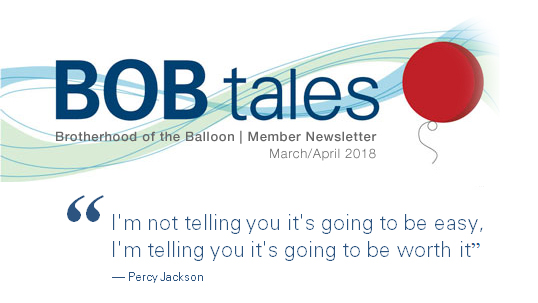
Dear Members:
Insurance coverage for proton therapy is probably the single biggest challenge we have faced in recent years. Science, logic, and the laws of physics tell us that proton therapy is superior to X-rays for treating prostate cancer because significantly less radiation is deposited on healthy tissue. One would expect fewer side effects as a result, as well as a much lower risk of secondary cancers later in life. Certainly this is the widespread belief when treating cancers in pediatric patients. Recent studies comparing proton to IMRT in treating patients with head and neck sarcomas, as well as esophageal cancer, show clear benefits with proton, particularly with regard to quality of life issues. We report on one of these studies in this month’s BOB Tales and another in next month’s issue.
Nevertheless, a large and growing number of private insurers are denying coverage for proton therapy for treating prostate cancer. The reason? Because there haven’t been prospective clinical studies to prove conclusively that proton is superior and to justify the higher treatment cost.
A solution to this problem may be on the horizon. We have mentioned in previous newsletters that after two failed attempts, a project team led by Dr. Nancy Mendenhall, medical director at University of Florida Health Proton Therapy Institute, has won funding approval by the Patient-Centered Outcomes Research Institute to conduct a study comparing proton therapy to IMRT for treating prostate cancer. PCORI is a government-sponsored organization charged with investigating the relative effectiveness of various medical treatments.
Deb and I are privileged to be part of the project team along with clinical representatives from every proton center in the country as well as research, administrative, and vendor representatives. Representatives from several IMRT treatment centers in the U.S. are also members of the PCORI project team.
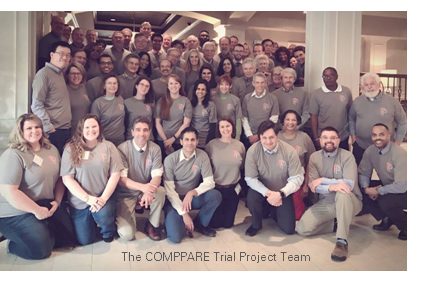 My role on the project team is as a patient stakeholder. I am also honored to serve on the executive board. Deb’s role on the team is as a patient caregiver.
My role on the project team is as a patient stakeholder. I am also honored to serve on the executive board. Deb’s role on the team is as a patient caregiver.
We consider this project to be one of the most important things happening in the proton world. Over the weekend of February 2-4, Deb and I attended the kick-off workshop in Amelia Island, Florida where there were 72 people in attendance representing virtually all the proton centers in the U.S. as well as several IMRT centers.
Since negotiations with PCORI have not been completed and Institutional Review Board approvals are not in place, we cannot discuss details of the project. As soon as we are allowed, we will share with you information about the size, scope, and other details of this comprehensive landmark study. We will also let you know about the key role you, our membership, can play in helping to ensure the success of this project.
There is another important study underway, which was reported at our workshop; we can talk about this one. It’s another trial comparing proton therapy to IMRT in treating prostate cancer. We are covering the PARTIQoL Trial as our lead story in this month’s BOB Tales. I’m sure this subject will interest our readers.
We have another full and informative newsletter this month. As always, we welcome and encourage your feedback and suggestions. Just send us an email.
Bob Marckini.
To print the BOB Tales newsletter or view the newsletter with a larger font size, click here for the PDF file.
In This Issue:
- The PARTIQoL Trial: Proton vs. IMRT
- Prostate Cancer and Conflicting Info on Soy
- What Might Make Recurrence More Likely?
- High Fat Diet May Promote Prostate Cancer Metastasis
- Prostate Removed, But No Cancer Present—Quality of Life Severely Impacted
- Should Different Prostate Cancer Screening Guidelines Exist for Black Men?
- Proton Therapy More Tolerable than Conventional Radiation for Treating Head and Neck Sarcomas
- Deb Hickey to Speak at 2018 National Association for Proton Therapy Conference
- Blueberries “Trick” Cancer Cells
.jpg)
PARTIQoL Trial: Proton vs. IMRT
All projects need a name, and some of them can be quite creative. The acronym PARTIQoL stands for Prostate Advanced Radiation Technologies Investigating Quality of Life. The name is also a play on the term “particle therapy” which refers to the proton segment of the trial.
Proton beam therapy and Intensity Modulated Radiation Therapy (IMRT) are both considered advanced radiation technologies. The PARTIQoL study is the first randomized trial of its kind to evaluate proton therapy vs. IMRT. Patients with low- or intermediate-risk prostate cancer have been invited to participate.
It is widely known that both proton therapy and IMRT do an excellent job killing prostate cancer cells. The debate, however, is about which treatment causes fewer side effects such as bowel, urinary, and erectile problems, thus the “Quality of Life” component.
Scientists have reason to believe that proton therapy may cause fewer side effects because the proton particle can be stopped at the target with minimal radiation to healthy tissue, but studies have not been done to prove or disprove this theory. Because of this lack of data, insurance companies have been reluctant to cover the higher cost of proton therapy for prostate cancer. The PARTIQoL study should help resolve this issue.
There are seven institutions involved in the study with three more to join soon. These institutions include MGH in Boston, MD Anderson in Houston, University of Pennsylvania in Philadelphia, University of Washington in Seattle, Princeton Radiation Oncology in New Jersey, Washington University in Missouri, and Northwestern Medicine Chicago Proton Center in Illinois. Soon to join the study are Provision Cancer Center in Tennessee, Rutgers Cancer Institute in New Jersey, and Memorial Sloan Kettering Cancer Center in New York.
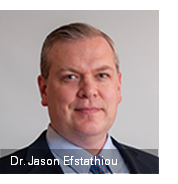 Jason Efstathiou, MD from MGH is the principal investigator on this Phase III clinical trial. He addressed the group at the Amelia Island PCORI conference giving us an update on the PARTIQoL trial.
Jason Efstathiou, MD from MGH is the principal investigator on this Phase III clinical trial. He addressed the group at the Amelia Island PCORI conference giving us an update on the PARTIQoL trial.
Four hundred men will participate in this randomized study. There are 256 are enrolled with 144 to go. Patients are receiving the same equivalent dose of radiation from both treatments. The question will be the patient’s experience of side effects. The focus will be on patient- and physician-reported results beginning at two years after treatment and beyond. Some of the variables being studied include moderate hypo-fractionation, the use of rectal spacers, and pencil beam scanning.
In addition to biochemical control, end-points in the study include urinary, bowel, sexual function, and other quality of life issues. Initial treatment cost as well as follow-up treatment costs will also be monitored.
Since this project was initiated a few years ago, a number of patients in the study have reached the two-year primary end-point. There is no published data from the study. We hope to begin seeing data from this important study in the not-too-distant future.
If you are interested in learning more about the PARTIQoL study, you can contact Kelsey Ricci at 617-643-2985 or email [email protected].
Prostate Cancer and Conflicting Info on Soy
Dozens of members have written in with questions about the recent, conflicting news reports on prostate cancer and soy consumption. Here is what we’ve learned:
Does eating more soy reduce prostate cancer risk? One study says yes.
Researchers from the University of Illinois found the more soy-based foods a person eats, the lower his chance of getting prostate cancer. The subject has been studied for nearly 30 years.
Researchers examined the results of 30 previous observational or epidemiologic studies. They found that men who consumed the most soyfood were 29 percent less likely to develop cancer than those who consumed less.
Men did not show decreased levels of testosterone from soy consumption; rather, they showed that naturally occurring isoflavones, such as genistein and daidzein, in soy reduced cancer risk. These compounds act like estrogen in humans and have been found to inhibit tumor cell growth.
The United States vs. Asia
The U.S. has one of the highest rates of prostate cancer compared to Asian countries which have significantly lower prostate cancer rates. The different rates are reportedly due to screening, genetics, and environmental influences.
Epidemiologic studies have tried to isolate the impact of genetics and environment by examining the incidence of prostate cancer among Chinese men living in China and the U.S. These studies found that those living in the U.S. had a 10-fold higher incidence of cancer. Other studies have shown similar trends in Japanese men living in the U.S.
Diet is presumed to play a key role in reducing the disease rate in Asian countries. In particular, it has been hypothesized that the high intake of soy in these countries may be responsible for the lower risk of prostate cancer.
As mentioned above, genistein is found in soy. Genistein has been targeted as a potent anti-cancer compound. In cell culture studies, researchers have found that genistein inhibits prostate cancer cell growth and also induces cellular death. Other studies have demonstrated that genistein enhances the ability of radiation to kill prostate cancer cells.
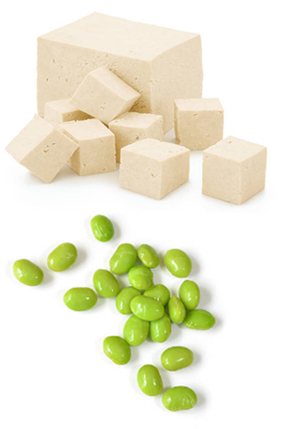 There has also been testing on rodents. Results showed rodents fed a diet high in soy were less likely to develop tumors.
There has also been testing on rodents. Results showed rodents fed a diet high in soy were less likely to develop tumors.
But what about that study that says tofu is linked to prostate cancer?
Researchers from the University of Indiana found tofu to be “significantly associated with prostate cancer,” but the dietary intake of isoflavones apparently has different effects on early stage versus advanced prostate cancer.
After analyzing dietary data from over 27,000 men over a 12-year period, researchers found the men who ate the most total isoflavones were 91 percent more likely to develop advanced prostate cancer than those who ate the least. However, there was no link between eating soy compounds and prostate cancer in general or non-aggressive prostate cancer—only to prostate cancer that was detected at a later stage, or the kind that is more likely to spread quickly.
So, what’s the link?
There are a few possibilities, says study author Jianjun Zhang, M.D., Ph.D. Because isoflavones are structurally similar to estrogen, it’s possible they trigger similar responses. Estrogen has been linked to prostate cancer because, as it’s broken down, its byproducts may become “genotoxic,” meaning they can damage genetic information in your prostate cells, possibly leading to cancer-causing mutations.
Researchers need to delve more deeply into why the link was seen only in advanced prostate cancer cases. In fact, many experts argue there isn’t enough concrete evidence to link soy products to prostate cancer at all.
Should you be worried?
According to Men’s Health nutrition adviser Dr. Mike Roussell, it’s “totally a non-issue” because this most recent study shows an association—not a cause-and-effect relationship. Plus, the estrogenic activity of soy might not be as clear as it sounds; prior data have shown that soy doesn’t actually increase levels of estrogen in men, according to Roussell. And this study didn’t look directly at how soy may or may not be influencing levels of that hormone, either.
Bottom line: You don’t need to change your diet based on one study, but if you’re worried, there are many other non-soy protein options.
What Might Make Recurrence More Likely?
Obesity and Metabolic Syndrome
Obesity and other health problems may increase the chances of prostate cancer returning, a new study finds. Researchers analyzed data from 1,100 prostate cancer patients who had radical prostatectomy between 2003 and 2013. Thirty-four percent were obese and 19 percent had metabolic syndrome (high blood sugar, obesity, abnormal cholesterol or triglyceride levels, and high blood pressure).
The patients were followed for an average of four years. Prostate cancer returned in more than 32 percent of obese patients compared with 17 percent of those who weren’t obese.
Patients with metabolic syndrome had a more than four times higher risk of prostate cancer return than those without the syndrome.
The study concludes that “prostate cancer patients who are obese or have metabolic syndrome undergoing [prostate removal] may have a higher chance for recurrence of the disease, and these individuals should have more focused follow-up care.”
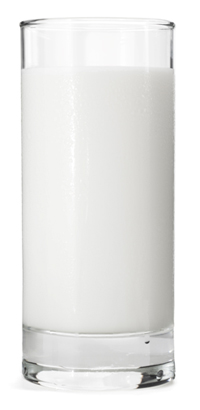 High-fat Dairy Intake
High-fat Dairy Intake
Another recent study shows a high-fat dairy, particularly whole milk, diet in healthy men may increase the risk of aggressive prostate cancer.
The study involved 1,334 men with non-metastatic prostate cancer. They answered a food-frequency questionnaire in 2004-2005 (median two years after diagnosis) and were followed until 2016 for recurrence, defined as: prostate cancer death, bone metastases, biochemical recurrence, or secondary treatment.
During a median follow-up of eight years, researchers found men who consumed more than four servings/week of whole milk had a 73 percent increased risk of recurrence. High body mass index (BMI) increased the association. Low-fat milk and other dairy foods were not associated with recurrence.
High Fat Diet May Promote Prostate Cancer Metastasis
We have all heard that prostate cancer usually grows slowly. But metastatic disease is a whole different story. Two new studies published in Nature Genetics and Nature Communications report that a high-fat Western diet might be a driving factor in the spread of prostate cancer.
Many studies have linked dietary fat with several cancers. Researchers report that cancer mortality rates in countries with high-fat diets are higher than in countries with lower fat diets.
Epidemiological data show that metastatic prostate cancer is much higher in nations where high-fat diets are common, such as the U.S. “In fact, in Asia only 10 percent of men develop prostate cancer. However, the rates are four times higher (40 percent) among Asian immigrants that come to the U.S. to live.” Researchers conclude that this suggests fat consumption is a key environmental trigger for aggressive forms of prostate cancer.
Studies conducted on mice showed that switching their diets from vegetable-based food to foods high in saturated fats resulted in more animals developing aggressive tumors.
Interestingly, a new drug being tested to treat obesity successfully caused tumors to regress in mice, blocking metastasis.
“These findings suggest a potential new therapeutic avenue for metastatic prostate cancer,” according to one article. It also suggests that physicians could analyze early-stage prostate cancer patients looking for those with certain tumor-suppressing genes and consider changing their patients’ diets to reduce the chance of tumor progression.
Prostate Removed, But No Cancer Present—Quality of Life Severely Impacted
This story is a man’s worst nightmare. Picture this: Your PSA is elevated; your doctor recommends a biopsy; you have the biopsy and are told you have aggressive prostate cancer; you are rushed into surgery; you have significant complications from the procedure. And then you discover you never had prostate cancer.
The St. Louis Post-Dispatch reported on just such a story. The patient was Harald Boerstler. His biopsy slides were mixed up with another patient’s. He was told he had prostate cancer; that it was invasive and aggressive, that surgery should be performed right away, and that local nerves and lymph nodes would also have to be removed.
A week after surgery when he visited his doctor to have the catheter removed and learn about the pathology report on what they removed, he discovered that he did not have prostate cancer; his prostate tissue was healthy. The aggressive cancer belonged to another patient. There had been a mix-up.
And things got worse. He experienced swelling of his scrotum “to the size of a grapefruit” and had to have the swollen area packed in ice. Three of the six incisions from the surgery were leaking. He had to have the catheter reinserted to relieve swelling caused by fluid building up in his bladder. When the catheter was removed a second time a bulge developed on the right side of his abdomen and over the next several days, lymphatic fluid needed to be drained twice. Boerstler also continues to deal with impotence and incontinence.
What’s further shocking about this case is that Boerstler had a DNA swab when he had the biopsy, which should have confirmed that the biopsy tissue samples analyzed were, in fact, his. This should have made it virtually impossible to mix up his test results with someone else’s. Somehow this didn’t work. Was it human error? Most likely.
Needless to say, legal action followed and a settlement was reached, but the specifics were not announced.
One question we might ask at this point: Whatever happened to the man with aggressive prostate cancer who was given Boerstler’s biopsy results and told he did not have cancer? According to the article, “the hospital intends to track him down …”
Stories like this are not common, but they probably happen more than one might imagine. We have a gentleman in our community here in Massachusetts who this happened to.
A story like this may be one more reason to choose a treatment that is kinder to your body than surgery, which seems to have a higher incidence of impotence, incontinence, and complications than other modalities. Next to active surveillance, we believe that a patient’s quality of life is best preserved when proton therapy is chosen for treating prostate cancer.
Should Different Prostate Cancer Screening Guidelines Exist for Black Men?
Yes, according to Matthew Cooperberg, MD, MPH, associate professor of urology at University of California, San Francisco.
Dr. Cooperberg believes that the excess burden of prostate cancer in black men should be an urgent public health priority. And he hinted at the disservice to both black and white men by the United States Preventive Service Task Force in 2012, suggesting the elimination of the PSA test because men were being over treated for prostate cancer.
The article published in HemOnc Today on Jan. 25, 2018, stated, “Black men are stricken earlier, more frequently, and more aggressively than any other group, resulting in twice the mortality rate as white men. There is also well-documented undertreatment of black men with high-risk prostate cancer.”
Dr. Cooperberg points to recent statistical modeling studies that provide compelling evidence that earlier PSA screening of black men (and white men with family history) would save lives. He suggests baseline screening at age 45.
Proton Therapy More Tolerable than Conventional Radiation for Treating Head and Neck Sarcomas
It seems that each time there’s a head-to-head comparison of proton vs. conventional radiation for treating different tumor sites, proton comes out on top for tumor control, quality of life, or both.
A recent study published in Pediatric Blood and Cancer (doi: 10.1002/pbc.26858) reported that young patients with head and neck sarcomas treated with proton beam therapy had similar results with less of an impact on quality of life as those treated with traditional photon radiation. Senior study author, Christine Hill-Kayser, MD, chief of pediatric radiation oncology at the University of Pennsylvania said, “These data show proton therapy is not only effective, it is also more tolerable for patients.”
Dr. Hill-Kayser and colleagues treated 69 pediatric patients with head and neck cancers using proton therapy. Ninety-three percent of these patients were still living one year after treatment with protons and 92 percent didn’t experience a recurrence at the primary disease site. None of the patients treated with protons experienced toxicities greater than grade 3. “The rate of side effects was well below what is expected with traditional photon radiation,” researchers said.
BOB Comment: As seen in so many other studies treating many tumor sites, the pinpoint accuracy of proton beam radiation therapy and the minimal deposition of radiation to healthy tissue—versus conventional radiation—result in less collateral damage and thus fewer side effects. One can extrapolate these results and predict a very favorable result when the PCORI study comparing proton to IMRT for treating prostate cancer is completed.

“I will soon be 74, but I feel 47!”
When we ask for feedback in the opening memo, we mean it. If you think we say too much, too little, or aren’t providing the information you care about, we want to know. If you feel our newsletters are too long (or too short?!) we want to know. And if you don’t have any criticism, write in anyway and let us know how we’re doing and how you’re doing. Last month, BOB member Larry Hagemann of Durham, NC reached out just to tell us he’s doing great 10-plus years since he was treated with proton therapy at Loma Linda. He also told us how valuable he finds our newsletter. We love hearing that; it makes all the work we do worthwhile. Here’s an excerpt from Larry’s message:
It has been 10-plus years since my Loma Linda proton treatment. I have faithfully followed your newsletter ever since, and have forwarded it to many others … It has been great to see the expansion of the BOB organization, under the guidance and leadership provided by Bob Marckini and Deb Hickey.
After being diagnosed with prostate cancer in 2007, I stumbled onto the proton miracle via my college roommate in Illinois who worked on some of the first nuclear devices for Loma Linda. Some of his fellow engineers actually became early patients at Loma Linda and easily attested to the program. Bob Marckini’s book came out about the same time. Based on conversations with other “happy customers,” I was soon off to the races. Loma Linda was just as Bob said: There were no surprises. I am happy to see that his book continues to be a best seller.
I was married in 2006 just before going to Loma Linda. Karen and I have celebrated both our 11th wedding anniversary this past year, along with my proton anniversary. I am pleased to report that my love for her has grown over this time, just as my PSA has diminished to flat-line levels. I could not be happier. There have been no proton side effects at all.
I have out-lived my knife-happy urologist and have lost 40 pounds to get my BMI back to my “Baywatch body” days. We have added one grandchild since 2007 and I am retired and working on family genealogy and photo history. I will soon break through age 74, but feel 47! The BOB newsletter recipes are well received and we thank you for these contributions to our good health.
These happy 10+ years have been given to us because of the proton beam pioneering efforts at Loma Linda, and through the hard work and support given to the hospital by Bob, Deb, and the many other team members. May God continue to shower us all with His loving generosity!

“It’s a privilege for me to have the ability to give back …”
Sometimes we feel the need to recognize the many ways some of our members support the proton community. On occasion, a member prefers to stay out of the spotlight, but understands we like to share these stories because they inspire us.
 Last month, Deb reached out to a member in Fargo, ND. She had many reasons to thank him. Most recently, he made a year-end contribution to proton research at Loma Linda University Health via the Robert J. Marckini Chair. In fact, she’d seen his name on several contributor lists in the past. She also recognized his name as he had submitted a testimonial of his journey through prostate cancer and proton therapy years earlier. After a quick search, Deb also found he was named by some BOB members as the key person who educated them about proton therapy. Further, he’d assisted a few prospective proton patients with their medical insurance appeals years after he completed his treatment.
Last month, Deb reached out to a member in Fargo, ND. She had many reasons to thank him. Most recently, he made a year-end contribution to proton research at Loma Linda University Health via the Robert J. Marckini Chair. In fact, she’d seen his name on several contributor lists in the past. She also recognized his name as he had submitted a testimonial of his journey through prostate cancer and proton therapy years earlier. After a quick search, Deb also found he was named by some BOB members as the key person who educated them about proton therapy. Further, he’d assisted a few prospective proton patients with their medical insurance appeals years after he completed his treatment.
Deb asked him to share his reason for all the support he’s given. His reply is below.
My primary reason for “giving back” is gratitude. I’m grateful for the advice and support I received from Bob Marckini’s emails prior to my treatment decision. I’m grateful for the BOB and all it does to promote proton treatment and help prostate cancer patients; I’m proud to be a member and glad that I can help in some small way. I’m also grateful for the tremendous care I received at Loma Linda and for the friendship of fellow patients I met during treatment. My proton treatment was a life-changing experience and I’m a better person for it today.
I feel it’s a privilege for me to have the ability to “give back” to help proton therapy evolve into a universally accepted treatment. I plan to continue making yearly contributions as long as I’m able.
He later told Deb he doesn’t expect recognition for giving back. He feels fortunate to be at a point in his life where he’s financially able to give. We’re grateful for him.
How to Give to Proton Therapy Research
- Donate Online: Visit the LLUCC website.
- Send a Check: Make it out to “LLUCC Proton” with “Marckini Chair” on the memo line and send to: LLUH, Office of Philanthropy, P.O. Box 2000, Loma Linda, CA 92354.
- Make a Call: Contact Elvia DeHaro at 909-558-501
How to Give to Vision 2020
- Donate online: Visit the LLUH website.
- Send a check: Make it out to: “LLUH Vision 2020.” Mail to: LLUH, Office of Philanthropy, P.O. Box 2000, Loma Linda, CA 92354.
- Make a call: Call 909-651-2020.
How to Make a Future Gift
- Make a future gift: Contact Todd Mekelburg at the Office of Planned Giving at Loma Linda University Health at 909-558-5376 or [email protected].
- Other ways to give: Contact Matt Miller at the Office of Philanthropy at Loma Linda University Health at 909-558-3582 or [email protected].


NAPT 2018
The National Association for Proton Therapy (NAPT) is the voice of the proton therapy community—providing education and awareness for the public, professional and governmental stakeholders about the benefits of proton therapy for treating cancer.
Join the NAPT for the sixth annual National Proton Conference (March 25 – 28, 2018) at the Scottsdale Resort at McCormick Ranch in Scottsdale, AZ. Proton therapy physicians, physicists and administrators from around the world will attend. An exhibition hall will showcase proton-related technologies. And the program will cover a variety of interesting subjects relating to new proton technologies, insurance coverage, design and evolution of new proton centers, and other timely topics.
 Deb Hickey to Speak on Panel
Deb Hickey to Speak on Panel
Deb has been asked to speak on the panel, Advocating for Proton Therapy. Deb is honored to speak about the BOB organization and our mission to spread awareness and educate others about proton therapy for prostate cancer.
Specifically, she’ll discuss the importance of educating yourself when considering the many prostate cancer treatment options available; the value in speaking with former patients representing each treatment option being considered; and the many ways the BOB advocates for proton therapy.
Deb will also talk about the many ways our members “pay it forward” and become “ambassadors” for the cause by sharing their own experiences through testimonials, personal blogs, writing books, submitting letters and articles to local media, establishing and/or attending local support groups, and much more.
Please join us at the 2018 NAPT conference!

Blueberries “Trick” Cancer Cells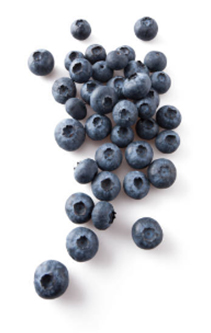
Blueberries are packed with antioxidants that offer a wealth of health benefits. A new study has uncovered another use—helping to treat cancer.
By studying human cervical cancer cell lines, researchers discovered that adding blueberry extract to radiation therapy can significantly improve treatment efficacy. A research team, led by Dr. Yujiang Fang at the University of Missouri-Columbia, tested the extract both alone and in combination with radiation therapy. These effects were compared with those of radiation therapy alone.
While radiation therapy alone reduced the number of cancer cells by 20 percent, the blueberry extract alone led to a 25 percent reduction in cancer cells. However, when the blueberry extract and radiation therapy were combined, the number of human cervical cancer cells fell by around 70 percent.
The researchers explain that the blueberry extract does not only make cancer cells more sensitive to radiation, but it also reduces the abnormal cell growth that fuels cancer development.
“Cancer cells avoid death by remodeling themselves,” said Dr. Fang. “Along with reducing cell proliferation, the extract also ‘tricks’ cancer cells into dying. So it inhibits the birth and promotes the death of cancer cells.”
While more research is needed, these findings indicate that blueberries may be a promising treatment strategy for cervical cancer and other cancer types.
The Magical Vitamin D
We have written in the past about multiple studies showing the benefit of taking vitamin D to help prevent prostate cancer or to help prevent a recurrence. Famed prostate cancer expert, Dr. Charles “Snuffy” Myers, suggests that those dealing with prostate cancer should monitor their vitamin D levels through periodic blood tests and maintain D levels in the high end of the normal range. For most of us, this means taking vitamin D3 daily as we often don’t get enough sunshine to naturally produce adequate D levels.
As Dr. Myers has commented in the past, not all vitamins are created equally and you should choose reputable suppliers to ensure you are getting the dosage shown on the label. One of his favorite suppliers is Life Extension. LE vitamins can be purchased directly from the company or from Amazon.
In addition to helping prevent prostate cancer, vitamin D has been shown to help maintain healthy bones and teeth, support the health of the immune, brain, and nervous systems, help regulate insulin levels and aid in diabetes management, support lung function and cardiovascular health, and influence the expression of genes involved in cancer development.
Adrian Martineau, B Med Sci, PhD, clinical professor of respiratory immunity and infection at Centre for Primary Care and Health in the UK says that vitamin D can help those who suffer from asthma. In one study, those who took vitamin D supplements were 50 percent less likely to need hospitalization and 30 percent less likely to have subsequent attacks requiring systemic corticosteroids. He suggests that asthma patients should ask their doctors to test their vitamin D levels and discuss supplementation if the level is low.
.jpg) Website for Medical Emergencies
Website for Medical Emergencies
Did you ever wonder what you should do if you are with someone who experiences a medical emergency, such as a heart attack, severe allergic reaction, bleeding, burn, choking, dislocation, shock, snake bite or is unconscious?
Calling 911 is a good first step, but there are certain things that you can do while waiting for help that could save a life or prevent serious complications from the event.
University of Iowa Hospitals and Clinics have established a website that lists dozens of injuries, alphabetically, with information on steps you can take to help stabilize the victim and maybe save his or her life.
When you click on an emergency, such as bleeding, the website provides 1) a definition of what may be going on; 2) alternative names for the emergency; 3) causes; 4) symptoms; 5) first aid; 6) things not to do; 7) when to contact a medical professional; and 8) prevention. References are provided for each emergency category.
We don’t know if this app is available for smart phones. Not everyone has quick access to a computer in an emergency, but smart phones are everywhere.
.jpg) Removing Pesticides from Apples
Removing Pesticides from Apples
A study by researchers at University of Massachusetts and Massachusetts Pesticide Analysis Laboratory in Amherst reported that you can easily remove pesticide residue from conventionally grown apples by mixing one teaspoon of baking soda in two cups of water. Submerge the apples in a bowl with a cover for two minutes, then rinse. Better yet, buy organic! The study was published in the Journal of Agriculture and Food Chemistry.
New Shingles Vaccine More Effective
Alan Taege, MD, staff physician in the department of infectious diseases, reports in Bottom Line Personal, that a new shingles vaccine is 90 percent effective in preventing the disease versus the current, Zostavax, which is only about 50 percent effective.
The new vaccine is Shingrix, produced by GlaxoSmithKline and FDA approved. Shingrix requires two shots rather than one.
The CDC’s Advisory Committee recommends getting the new vaccine even if you already have been vaccinated with Zostavax.
 Series: “Make Vegetables Taste Good”
Series: “Make Vegetables Taste Good”
This is the 18th segment on a subject that’s consistent with our Anticancer series. We made it our mission to find recipes that make the most healthful vegetables taste delicious. And, we’ve tried them all!
“I’m on a sweet potato kick and this recipe from Love Real Food is near perfection,” says Deb Hickey. “Also, don’t be surprised if you see other recipes from this cookbook. It’s my new favorite.”
Note the recipe calls for four medium-sized potatoes, but Deb made it with two large potatoes (to serve two). All the other ingredients were kept intact. This way we had extra topping (Deb ate it for breakfast the next day).
Quinoa-stuffed Sweet Potatoes
Ingredients:
- 4 medium sweet potatoes, scrubbed clean
- 1 cup quinoa, rinsed
- 2 cups water
- ½ cup raw pepitas (hulled pumpkin seeds—delicious!)
- ½ teaspoon plus 3 tablespoons extra-virgin olive oil
- 1 can (15 oz.) chickpeas, rinsed and drained, or 1 ½ cups cooked chickpeas
- ½ cup chopped green onion (about 4)
- ½ cup chopped fresh flat-leaf parsley
- 2 cloves garlic, pressed or minced
- 3 tablespoons lemon juice (from 1 to 1 ½ lemons)
- Fine sea salt
- ½ cup crumbled goat cheese (about 2 ½ oz.)
Directions: Preheat the oven to 400°F. Line a rimmed baking sheet with parchment paper to catch any sweet potato drippings.
Pierce each sweet potato several times with a fork to allow steam to escape while cooking. Place the sweet potatoes on the prepared sheet and bake until they yield to a gentle squeeze and are cooked through, 45 minutes to one hour.
In a medium saucepan, combine the quinoa and water. Bring the mixture to a boil over medium-high heat, then reduce the heat as necessary to maintain a gentle simmer. Simmer, uncovered, until all of the water is absorbed, 15 to 20 minutes. Remove the pot from the heat, cover, and let the quinoa steam for five minutes. Uncover and fluff the quinoa with a fork.
In a medium skillet, combine the pepitas and ½ teaspoon of the olive oil. Cook over medium heat, stirring frequently, until the pepitas are turning golden on the edges and making little popping noises, about five minutes. Pour the toasted pepitas into a large bowl.
To the bowl, add the chickpeas, green onion, parsley, garlic, lemon juice, ½ teaspoon salt, and the remaining three tablespoons olive oil. Toss to combine. Add the fluffed quinoa to the bowl and stir until the ingredients are evenly distributed. Taste and add additional salt, if necessary, and more lemon juice if you would like a tangier flavor.
Wait to add the goat cheese until you’re ready to serve, so it doesn’t melt into the quinoa. When it’s time, add the crumbled goat cheese to the bowl and gently stir to combine.
To assemble, use a small paring knife to slice down the middle of the sweet potatoes, leaving about 1 inch intact on each end. Squish the ends toward the middle a bit to open them up. Transfer each sweet potato to its own plate. Sprinkle the interiors of the sweet potatoes with a dash of salt and use a fork to gently mash up the insides a bit, which will make room for more filling. Fill the potatoes with the quinoa mixture, letting extra filling overflow to the sides.

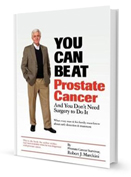
Amazon Reviews Carry Weight
Was it something about this section’s title last month that prompted several of our members to write Amazon reviews for Bob Marckini’s book, You Can Beat Prostate Cancer? Whatever the reason, we are thankful for those who took a few minutes to submit a couple of sentences, and those who wrote some pretty comprehensive paragraphs, about how Bob’s booked helped you learn more about proton therapy.
As we mentioned last month, Amazon’s search engine algorithm works pretty simply—the more reviews, the more visibility. So we asked our newsletter readers to please help us reach 400 Amazon reviews in 2018!
If Bob’s book, You Can Beat Prostate Cancer, was helpful to you, please post a review. Click on the gray “Write a Review” button.
Bob’s book still shows up in the No. 3 position on a search for “prostate cancer”—but the competition is mounting. Newly diagnosed men need to know that surgery and traditional radiation are not the only treatment options. They need to learn to be their own advocate; do their own homework; and make the best treatment decision for themselves. Please help us keep the book easily accessible to newly diagnosed men and their family members. Thank you!
A recent review is below.

READ THIS BEFORE YOU DECIDE TREATMENT DIRECTION
This book contains life-changing facts and revelations about a treatment strategy that NONE of my doctors would lend any credence to at all! This technology has been in use for almost 30 years, but the doctors still refer to it as “experimental” or “overkill” and not necessary for prostate treatment. I strongly recommend this as required reading for anyone in my position searching for the best options.
I was diagnosed in December 2017. Like most men, I headed down the path of normal discussion with the various doctors involved and my initial intention and position was, “I don’t want to get cut unless I have to.” After several consults and research,
I was concerned about the side effects and uncertainty of long periods of hormone treatment and regular radiation treatment. I soon found myself resigned to the fact that surgery seemed to be the best, most absolute, and possibly the most predictable method of treatment.
Then my friend Charles gave me Bob Marckini’s book. It opened my eyes to an entirely new perspective on a THIRD methodology of treatment that EVERY doctor
I have spoken with dismissed or discounted and minimized—proton beam radiation therapy. I would NOT dream of any other method of treatment now that I have read Bob’s book and researched the options.
If you found Bob’s book helpful in your journey to proton therapy, please help others find it by posting a review on Amazon.
Buy Online, in Bulk or in Spanish
Online: Paperback: $19.00--•--Kindle: $7.99--•--NOOK Book: $9.99--•--Apple iBook: $9.99
In Bulk: Conctact us for a discount price list. Proceeds from book sales support proton therapy research through the Robert J. Marckini Endowed Chair at LLUCC.
In Spanish: Buy the print version or in eBook format.

Beware of Money-Stealing Malware
According to Komando.com, a malware Trojan-horse program called Trickbot, is spreading through the Internet. Scammers send emails supposedly from your bank. The email appears to be a bill and has a PDF, Word, or Excel document attached. If you click on the attachment it installs Trickbot, which runs in the background until you try to get into your banking site. When you next visit your banking site Trickbot redirects to a realistic-looking phony site where you enter your banking credentials which are then used by thieves to empty your bank account.
How can you prevent this from happening? Just as with other malware, be cautious before clicking on any links; have strong security software and keep it updated; set up two-factor authentication; use unique and strong passwords; and never hand over personal data if you receive any unsolicited emails unless you are absolutely sure that the message is legitimate. Use a free password program like LastPass.
It’s a Bad Idea to Post or Trash Your Boarding Pass
Did you know that your travel boarding pass can easily be hacked, and your personal information can quickly be compromised? Every boarding pass contains a QR code. A hacker can use a bar code scanning app from any iPhone to scan the QR code to get your name, phone number, frequent flyer number, and flight information—all of which can be used to access your account, learn about future travel plans, alter or cancel reservations, reset the pin number, and gain access to passport number, citizenship, date of birth, and even more of your personal information.
And it’s not limited to paper boarding passes. The scanner can also read QR codes from a cell phone or iPad screen. So don’t take a picture of it and tweet it or post it on Facebook or Instagram.
How do you protect yourself? Don’t leave your boarding pass on the plane or intact in a trash can. If a hacker can find it, he can find you.
Did You Know?
- There’s enough concrete in the Hoover Dam to build a two-lane highway from San Francisco to New York City.
- Boston has the worst drivers out of the nation's 200 largest cities (Deb and Bob can attest to that!). Kansas City has the best drivers.
- The Empire State building has its own zip code.
- The Library of Congress contains approximately 838 miles of bookshelves—long enough to stretch from Houston to Chicago.
- There are around 5,000 commercial airplanes flying over the United States at any given time.
- At 46 letters, Massachusetts’s Lake Chargoggagoggmanchauggagoggchaubunagungamaugg has the longest place name in the U.S. … Learn how to pronounce it!
It’s Only Money
Guess what club these people belong to? Amancio Ortega, Carlos Slim Helu, Bernard Arnault, Larry Page, and Larry Ellison. Give up?
How about if we add five more: Jeff Bezos, Bill Gates, Warren Buffett, Mark Zuckerberg, and Charles Koch? Yes, these are the 10 wealthiest people in the world.
One interesting note: On the day, last month, when we first saw these statistics, CEO and Chairman of Amazon, Jeff Bezos’ wealth increased by $1.5 billion over the previous 24 hours (!) to $106.4 billion. He’s No. 1 on the list.
The combined wealth of the top 10 on that particular day in January was $730 billion. Here is the entire list of the 1,600 world billionaires. Maybe some of our members are on the list?

Last Month’s Brain Teaser
Three towns are located at the corners A, B and C of a triangle with equal sides. A car travels at constant speed from A to B at 30 mph, from B to C at 40 mph and from C back to A at 60 mph.
What is the average speed of the round trip?
Answer: 40 mph. Many would average, 30, 40 and 60 to come up with 43.3 mph, but that would be incorrect. The average speed is actually 40 mph. Say the sides of the triangle are 120 miles long. The trip from A to B would take four hours, the trip from B to C would take three hours and the trip from C back to A would take two hours. That’s nine hours to travel 360 miles, or an average speed of 40 mph.
Winner: Hans Buhler of Stanley, ID is the brain teaser winner for February. Hans is originally from Switzerland, born in the small mountain town of Lauterbrunnen. Four years later, Lotte Muhlemann was born in the same town. Twenty-three years after that, the two were married at the local church.
Adventure beckoned and they left Switzerland two weeks after their wedding to spend 18 months in Ontario and another 18 months in Calgary, Alberta, Canada. They had three daughters together.
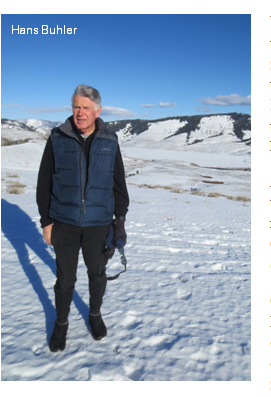 Over the years, Hans and Lotte moved to Pocatello, ID and Hans began working for a consulting engineering firm. Later he and two others started their own consulting engineering firm called Power Engineers, Inc (POWER). “I claim absolutely no credit but today POWER is a 100 percent employee owned with 2,100 employees and 44 offices in the U.S. and two international offices,” Hans said. When Hans retired in 2002, he started building a log home in Stanley, ID. Shortly thereafter, he began having high PSA readings. Over the years, he had a few biopsies, but they were negative. He was diagnosed with prostate cancer in 2011.
Over the years, Hans and Lotte moved to Pocatello, ID and Hans began working for a consulting engineering firm. Later he and two others started their own consulting engineering firm called Power Engineers, Inc (POWER). “I claim absolutely no credit but today POWER is a 100 percent employee owned with 2,100 employees and 44 offices in the U.S. and two international offices,” Hans said. When Hans retired in 2002, he started building a log home in Stanley, ID. Shortly thereafter, he began having high PSA readings. Over the years, he had a few biopsies, but they were negative. He was diagnosed with prostate cancer in 2011.
“My urologist was walking the talk,” Hans said. “He felt prostate cancer was way over-treated and having the disease himself, recommended watchful waiting just as he did for himself.”
Hans had a friend who lived locally. Incidentally, he was a member of the BOB, having been successfully treated with proton therapy for his prostate cancer. “He sent me the book, You Can Beat Prostate Cancer. It encouraged me to spend January through March 2012 getting proton treatment in Loma Linda,” Hans told us.
During Hans’ treatment, he and Lotte joined water aerobics and other activities including Wednesday night meetings at the Drayson Center. “Since no adverse symptoms appeared, the Loma Linda stay was a vacation away from wintery and cold Idaho.”
Hans and Lotte live an active life. They enjoy hiking, biking, cross-country skiing, and camping.
New Brain Teaser
A sundial has the fewest moving parts of any timepiece. Which has the most?
Send your answer to [email protected] for a chance to win a signed copy of Bob Marckini’s book, You Can Beat Prostate Cancer.
Oops!
My boss, who is on vacation, phoned me today. He said, “Is everything okay at the office?”
I said, “It’s all under control. It’s been a very busy here today. I haven’t stopped to take a break all day.”
“Can you do me a favor?” He asked.
I said, “Of course. What is it?”
“Pick up the pace a little. I’m in the foursome behind you.”
Kenny and the Farmer
A city boy, Kenny, moved to the country and bought a donkey from an old farmer for $100. The farmer agreed to deliver the donkey the next day.
The next day the farmer drove up and said, “Sorry son, but I have some bad news; the donkey died.”
Kenny replied, “Well then, just give me my money back.” The farmer said, “Can’t do that. I spent it already.”
Kenny said, “Okay then just unload the dead donkey.” The farmer asked, “What are you going do with him?”
Kenny: “I’m going to raffle him off.”
Farmer: “You can’t raffle off a dead donkey!”
Kenny: “Sure I can; watch me. I just won’t tell anybody he’s dead.”
A month later, the farmer met up with Kenny and asked, “What happened with that dead donkey?”
Kenny: “I raffled him off. I sold 500 tickets at two dollars apiece and made a profit of $998.”
Farmer: “Didn’t anyone complain?”
Kenny: “Just the guy who won. So I gave him his two dollars back.”
Kenny went on to become a member of Congress.
So, what is your name?
Pastor Joel Osteen likes to open his radio broadcasts with some humor. He told this story at the opening of a program last month.
A gentleman boarded a plane and sat next to a very attractive woman and they began a conversation.
Partway through the flight, he asked the young lady, “So, what kind of guys do you like to date?”
She said, “Actually I like three types of men. I’m attracted to American Indians; I find them hauntingly handsome. I also like Jewish men; they tend to be very smart and worldly. And finally, I find southern gentlemen to be polite and considerate, and I love a southern accent.”
“So, what is your name?” she asked.
“Oh, my name is Geronimo Bernstein,” he answered, “But my friends call me Bubba.”
Getting Old
- I’ve had two bypass surgeries, a hip replacement, two new knees, and fought prostate cancer and diabetes. I’m also half blind; I can’t hear anything quieter than a jet engine; I take 40 daily medications that make me dizzy, winded, and subject to blackouts; and I have bouts with dementia. Oh, and I have poor circulation—I can hardly feel my hands and feet anymore. I also can’t remember if I’m 88 or 92 and half the time, I can’t find my way to my own bathroom. ...Thank goodness I still have my driver’s license.
- Grant me the senility to forget the people I never liked anyway, the good fortune to run into the ones I do, and the eyesight to tell the difference.
Quote of the Month:
“The only things worth learning are the things you learn after you know it all.” —Harry S. Truman

This is a Flashback from our February 2004 BOB Tales. It’s an article written by Bob Marckini with an important message.
Last month I found a book in my mailbox. It was not wrapped in a package, and there was no note attached. The book was titled, Not Fade Away—A Short Life Well Lived, by Laurence Shames and Peter Barton. I asked my neighbors if any of them had left the book for me, or if it was intended for one of them. The answer was no to both questions. So I read it.
The book is about Peter Barton’s life, or rather the end of his life. Peter was a highly successful entrepreneur, who built a giant TV cable business and then retired in his early 40s. This was a man who had everything. From the time he was a child, he lived life to the fullest; he took risks; he played hard; he succeeded in everything he attempted. And he was on top of the world—until he was diagnosed with cancer.
Barton went after the disease the same way he dealt with everything in life—aggressively. After surgery and chemotherapy, he thought he had beaten the disease. But it returned. The book is about how he lived his life from that point on, and how he dealt with the knowledge of his certain death.
Believe it or not, it is one of the more uplifting books I have read. This is a man who had everything to live for: success in business, a young family, money, ideas, and boundless energy. Yet, in his mid-40s, when he knew his days were numbered, he began a journey of wonder and discovery that will grab your attention and teach you some important lessons of life.
He was agnostic, yet as his disease progressed and he examined the world around him; he began to see things that gave him reason to believe in a Higher Power. At one point, while counting his blessings, he said, “I sometimes think there must be an afterlife, if for no other reason than so my gratitude for these gifts can continue.”
There’s one part I really loved, and this helped put things in perspective for me. Barton was commenting on a scene from a favorite old movie, My Dinner with Andre.
“Andre is a romantic, an aesthete, a perfectionist. He tells his friend Wally that, for him, a great day has to be sublime, in every detail. There has to be a perfect meal at a perfect table overlooking a perfect sunset. One flaw anywhere and the experience is spoiled. Wally is just the opposite. He asks very little of life. He’s thrilled with whatever scraps of pleasure the world throws his way. A good day for him is when he wakes up in the morning, finds a cup of coffee left over from the day before, and discovers that no cockroach has crawled into it and died.”
Wouldn’t it be wonderful if we could live our lives as Wally did, appreciating and relishing everything we’ve been given? Wally had the great gift of seeing value in the little things and of seeing small delights as large victories.
Some of us will experience a recurrence of our cancer. We can learn much from Barton’s experience to help us through the difficult times. As an example, toward the end Barton said, “I take pleasure from each and every day. True, the pleasure often coexists with pain. True, the pleasure often takes the form of recollection. But so what? It’s pleasure nonetheless, and I savor it. Small pleasures loom large. As with anything in short supply, their value rises with their rarity. A favorite two-minute song can offer all the satisfaction of a symphony. There’s rapture in watching a dog chase a tennis ball. Sometimes a breeze from the west carries a pine smell down from the mountains.”
The older I get, the less I believe in coincidences. That book was left in my mailbox for a reason. Perhaps I was meant to read the book and share it with you.
I recommend this book, not just for those who experience a recurrence of their cancer, but for anyone who is interested in reading a touching story of someone who used the experience of his terminal illness to truly put life in perspective. We can all learn from that. And I thank whoever left it in my mailbox.
Low PSAs to all!
Bob Marckini and Deb Hickey
To print the BOB Tales newsletter or view the newsletter with a larger font size, click here for the PDF file.
NO MEDICAL ADVICE: Material appearing here represents opinions offered by non-medically-trained laypersons. Comments shown here should NEVER be interpreted as specific medical advice and must be used only as background information when consulting with a qualified medical professional.
